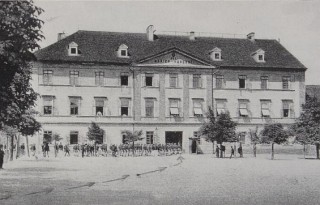
Mariánská kasárna in CB (Budweis). Until 1 June 1915 it was the home of the Good Soldier Švejk's Infanterieregiment Nr. 91. In 1915 Jaroslav Hašek also served with the regiment in these barracks.
The novel The Good Soldier Švejk refers to a number of institutions and firms, public as well as private. On these pages they were until 15 September 2013 categorised as 'Places'. This only partly makes sense as this type of entity can not always be associated with fixed geographical points, in the way that for instance cities, mountains and rivers can. This new page contains military and civilian institutions (including army units, regiments etc.), organisations, hotels, public houses, newspapers and magazines.
The line between this page and "Places" is blurred, churches do for instance rarely change location, but are still included here. Therefore Prague and Vienna will still be found in the "Places" database, because these have constant coordinates. On the other hand institutions may change location: Odvodní komise and Bendlovka are not unequivocal geographical terms so they will from now on appear on this page.
The names are colour coded according to their role in the plot, illustrated by these examples: U kalicha as a location where the plot takes place, k.u.k. Kriegsministerium mentioned in the narrative, Pražské úřední listy as part of a dialogue, and Stoletá kavárna, mentioned in an anecdote.
 Institutions index of institutions, taverns, military units, societies, periodicals ... (288)
Show all
Institutions index of institutions, taverns, military units, societies, periodicals ... (288)
Show all I. In the rear
I. In the rear  14. Švejk as military servant to senior lieutenant Lukáš (14)
14. Švejk as military servant to senior lieutenant Lukáš (14) II. At the front
II. At the front  1. Švejk's mishaps on the train (15)
1. Švejk's mishaps on the train (15) 2. Švejk's budějovická anabasis (38)
2. Švejk's budějovická anabasis (38) 3. Švejk's happenings in Királyhida (44)
3. Švejk's happenings in Királyhida (44) 4. New afflictions (26)
4. New afflictions (26)



|
II. At the front |
 | |
1. Švejk's mishaps on the train | |||
 | Nádraží císaře Františka Josefa |  | |||||
| Král. Vinohrady/300, Sadová silnice 2 | |||||||
| |||||||
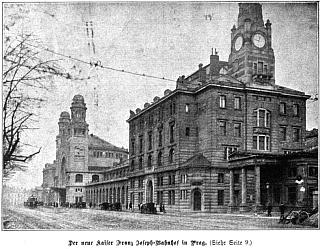
,27.1.1909

Nádraží císaře Františka Josefa (now Hlavní nádraží) is not mentioned explicitly but it is clear from the circumstances that Oberleutnant Lukáš and Švejk set out on their journey from this station. The trip got off to a bad start as their luggage was stolen at the station.
Background
Nádraží císaře Františka Josefa (Emperor Franz Joseph Station) was until 1918 the name of the main railway station in Prague. It has since then also been called Wilsonovo nádraží after president Woodrow Wilson. Since 1953 it has been named Praha hlavní nádraží (Prague main station). The station was opened in 1871 and is by far the busiest railway station in the country.
In 1914 the station had remote connection with Vienna and it served a number of other destinations both locally and regionally. It was one of the three major railway stations in Prague, together with Státní nádraží (now Masarykovo) and Severozápadní nádraží (now demolished).
Quote(s) from the novel
[II.1] „Poslušně hlásím, pane obrlajtnant,“ ozval se tiše Švejk, „doopravdy ho ukradli. Na nádraží se vždycky potlouká moc takových šizuňků a já si to představuju tak, že jednomu z nich se nepochybně zamlouval váš kufr a ten člověk že nepochybně využitkoval toho, jak jsem vodešel od zavazadel, abych vám vohlásil, že s našima zavazadlama je všechno v pořádku.
Also written:Emperor Franz Joseph StationenKaiser-Franz-Joseph-Bahnhofde
 | Severozápadní nádraží |  | ||||
| Praha II./1583, Tešnov 2 | ||||||
| ||||||

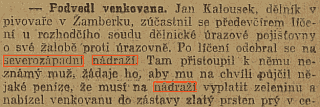
,5.7.1912
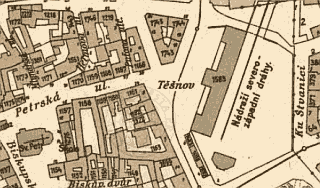
, 1909-1914
Severozápadní nádraží is mentioned when Švejk explains Oberleutnant Lukáš that theft at railway stations always occur. This was after their luggage had been stolen at the station they left Prague from, presumably Nádraží císaře Františka Josefa.
According to the soldier a theft took place here at the North West Station. A pram with a little girl was stolen and handed in at Švejk's local police station.
Background
Severozápadní nádraží (North West Station) was a major railway station in Prague, from 1953 called Praha-Těšnov. It was located in Florenc and was in service until 1972. (The building was demolished in 1985). It was from here Jaroslav Hašek painter Panuška together with took the train to Světlá nad Sázavou (on his way to Lipnice) on 25 August 1921.
In Prague it was the main hub of Österreichische Nordwestbahn, a private railway operator that was founded in 1868 and functioned until it was nationalised in 1909. The headquarters were located in Vienna. During Austria-Hungary the station served Vienna and Berlin, and several regional desitinations.
Attempts to find any mentioning of the episode with the stolen pram have been futile. If the soldier is to be believed the theft took place in 1912 and the child handed in at Policejní komisařství Salmova ulice (the police station closest to where we assume that Švejk lived).
It should also be noted that Jaroslav Hašek was a reporter on local affairs in České slovo for a period in 1908 and 1912 and it can't be ruled out that he re-used one of his own reports (it has even been claimed that some of these were invented).
Quote(s) from the novel
[II.1] Před dvěma léty na Severozápadním nádraží ukradli jedné paničce kočárek i s holčičkou v peřinách a byli tak šlechetní, že holčičku vodevzdali na policejním komisařství u nás v ulici, že prej ji našli pohozenou v průjezdě. Potom noviny udělaly z tý ubohý paní krkavčí matku.“
Also written:North West StationenNordwestbahnhofdeNordveststasjonenno
Literature
- Jaroslav Hašek na Vysočině, ,2014
 | Neue Freie Presse |  | ||||
| Wien I., Kolowratring, Fichtegasse 12 | ||||||
| ||||||
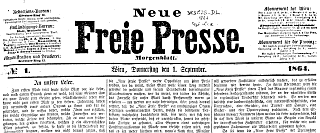
The front page of the first issue, 1.9.1864
,1.9.1864
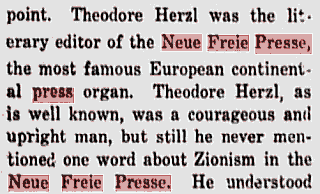
, 29.10.1920
Neue Freie Presse is mentioned in connection with Švejk and Oberleutnant Lukáš and their train journey to Budějovice. Opposite them in the compartment sat a completely bald man and red this paper. Later it became clear that this man was the notorious Generalmajor von Schwarzburg.
Background
Neue Freie Presse was a daily newspaper that was published in Vienna from 1864 to 1939, founded as a break-away from Die Presse. It published both a morning and an evening issue. It's political stance was bourgeois liberal, along the lines of e.g. Prager Tagblatt and Bohemia.
The newspaper eventually became very influential, led by the powerful editor in chief, Moritz Benedikt (1849-1920). It was also one of the largest of its kind in Austria, employing around 500, and it also enjoyed a reputation abroad. They were known for outstanding journalism and succeeded in enlisting writers like Theodor Herzl, Hugo von Hoffmannsthal, Bertha von Suttner and Stefan Zweig.
During World War I they took an aggressive patriotic stance, but had also during the French-German war in 1870-71 shown a pro German tendency.
In the inter-war years the newspaper continued to publish but was closed by the Nazis in 1939. The paper always had many Jewish employees and Benedikt himself was of Jewish descent.
Quote(s) from the novel
[II.1] „Dohromady nic, pane obrlajtnant,“ odpověděl Švejk, nespouštěje oči s lysé lebky civilisty sedícího naproti nadporučíkovi, který, jak se zdálo, nejevil pražádný zájem o celou záležitost a četl si „Neue Freie Presse“, „v celým tom kufru bylo jen zrcadlo z pokoje a železnej věšák z předsíně, takže jsme vlastně neutrpěli žádný ztráty, poněvadž zrcadlo i věšák patřily panu domácímu.“
Literature
- Wien, 27. Juli, ,28.7.1914
- Neue Freie Presse,
- Verzeichnis der in Wien erscheinende Zeitungen, ,1914
- Moritz Benedikt,
- Idylka z pekla, Jaroslav Hašek,12.6.1908
- Ein Jubiläum der "Neuen Freien Presse", ,31.8.1914
- Im Raimund-Theater, ,5.10.1930
 | V čubčím háji |  | ||||
| Praha II., Nekázanka ul. | ||||||
| ||||||
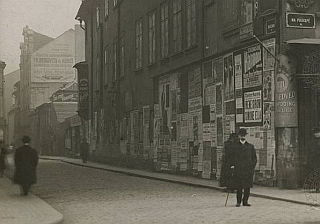
, 1907
V čubčím háji is mentioned in an anecdote by Švejk when he tells Oberleutnant Lukáš about Nechleba who always wants to do good but rarely succeeds.
Background
V čubčím háji (The Bitches' Grove) was according to Švejk a pub in Nekázanka but additional information is not available. The name has surely been a colloquial term for an existing pub in the street or even a somewhere else. In 1910 there were several pubs in the street, where the best known was U zlatého křížku.
| Folta Josef | 858-II. Nekázanka 1 |
| Hýna Antonín "U zlatého křížku" | 880-II. Nekázanka 7 |
| Stejskal Karel | 879-II. Nekázanka 9 |
Quote(s) from the novel
[II.1] „Poslušně hlásím, že jsem to, pane obrlajtnant, pozoroval. Já má, jak se říká, vyvinutej pozorovací talent, když už je pozdě a něco se stane nepříjemnýho. Já mám takovou smůlu jako nějakej Nechleba z Nekázanky, který tam chodil do hospody ,V čubčím háji’.
Also written:The Bitches' GroveenHündin im Hainde
Literature
- Románové restaurační a jiné zábavní podniky, ,2009 - 2021
- Otevření restaurace, ,15.8.1909
 | U Špírků |  | |||
| Praha I./1024, Kožná ul. 14 | |||||
| |||||
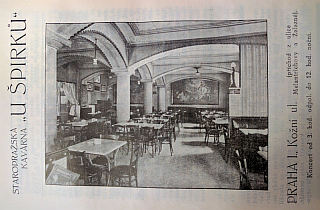
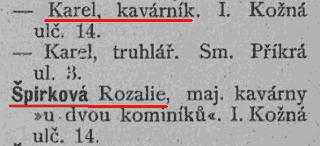
Adressář hl.m. Prahy 1896
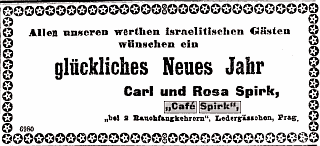
,26.9.1897
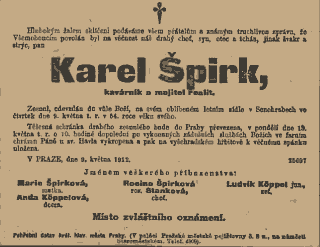
,11.5.1912

,5.3.1916

,27.9.1929
U Špírků is mentioned on the train to Budějovice as Švejk loudly ponders the possible causes of loss of hair, and unfortunately quotes a medical student from U Špírků on this. The bald gentleman sitting opposite him is the feared Generalmajor von Schwarzburg, who doesn't take lightly to Švejk's comments.
Background
U Špírků was a coffee-house in Staré město in Prague which still exists albeit in a different setting. According to the restaurant's website it was founded as early as 1870 and renovated in a traditional style between 2004 and 2006.
The café is not listed in the pre-war address books, but in 1891 the police registered a certain Karel Špirk, entered with cafetier as occupation. During the 1890's Špirk and his wife on several occasions placed adverts in Prager Tagblatt where they wishes their Jewish guests a Happy New Year. In the 1896 address book the café is entered under the name U dvou kominíků (At the two Chimneysweeps) with wife Rozalie Špirková as the owner.
In 1912 Národni listy reported that Karel Špirk had passed away and they also add that he was 54 years old, was a café owner and a proprietor of real estate. Špirk was according to the police books born 12 October 1858 in Prague so the connection to the café is indisputable. He was married to the ten year younger Roselie, and they had a daughter Anna who was born in 1887. Karel Špirk died on 9 May 1912 in Senohraby and was buried at Vyšehrad cemetery.
A newspaper notice in Právu Lidu from 1916 confirms that the café was still in business and that it was subjected to a police raid on suspicion of illegal prostitution (Tunel is mentioned in the same item). As late as 1929 adverts reveal that the establishment was still running, now officially using the name U Špírků. They hosted concerts, and served Prazdroj (Pilsner Urquell).
The owner in 1924 was Josef Baloun. In 1936 Marie Balounová was the owner. A picture from 1945 reveals that the establishment survived the Nazi protectorate. During the first republic U Špírků also functioned as an unofficial brothel (licensed brothels were banned in 1921).
Another "U Špírků"
From 1920 onwards another tavern carrying the name appears in newspaper adverts. It was located in Sokolská třída in Nové město and is also a place the author surely would have known about as he frequented this part of the city a lot (see Apollo, Bendlovka, and U kalicha). Newspaper adverts reveal that this U Špírků was often used for meetings. Although there is no trace of this café in pre-war address books, one shouldn't rule out "backdating" as Jaroslav Hašek at times added pieces of information to his novel that were chronologically at odds with the 1914/1915 plot. See Siedliska, Artur Lokesch, and Kriegskalender for more examples.
Quote(s) from the novel
[II.1] “A pokračoval neúprosně dál: „Potom říkal jednou jeden medik v kavárně „U Špírků“, že padání vlasů zaviňuje duševní pohnutí v šestinedělí.“
Literature
- Románové restaurační a jiné zábavní podniky, ,2009 - 2021
- Pobytové přihlášky pražského policejního ředitelství, ,1851 - 1914
- Soupis pražských domovských příslušníků 1830-1910 (1920),
- Glückliches Neues Jahr, ,26.9.1897
- Umrtí, ,11.5.1912
- Poděkování Karla Špirka, ,14.5.1912
- Boj s prazškou prostituci, ,5.3.1916
- Opet mystifikace, ,4.2.1934
- O nás,
 | Banka Slavia |  | ||||
| Praha II./978, Havlíčkovo nám. 23 | ||||||
| ||||||

Rozkvět, 10.4.1910

Český Lloyd, 13.9.1902
Banka Slavia is mentioned on the train to Budějovice when Švejk in an innocent manner asks general Generalmajor von Schwarzburg if he may happen to be Mr. Purkrábek, the representative of this bank.
Background
Banka Slavia was a mutual insurance company (and bank) with headquarters at Havlíčkovo náměstí. The company was founded in 1868 by a group of businessmenn led by F. L. Chleborad. The first general assembly was held 14 May 1869. The company expanded quickly and by the turn of the century they were established in Prague, Brno, Vienna, Lwów, Zagreb and Lubljana. At the outbreak of war they were present also in Sarajevo.
The inter-war years saw the firm prosper even more and they were part owners of many foreign financial institutions, even as far as New York. They remained in business until 1945.
Hašek and Slavia
Jaroslav Hašek was employed as an apprentice by the bank from October 1902 until he was dismissed in June 1903. The reason was two longer absences without permission, the latest occurred 30 May 1903. Hašek disappeared without a trace and went off on a trip that may have lasted up to 4 months.
The author's family were strongly connected to Slavia: both his father Josef and his younger brother Bohuslav worked for the bank.
Quote(s) from the novel
[II.1] „Dovolte, vašnosti, neráčíte být pan Purkrábek, zástupce banky Slavie?“
Credit: Vojtěch Pojar, Radko Pytlík
Literature
- "Slavia", vzájemně pojišťovací banka v Praze, ,1910
- "Slavia", vzájemně pojišťovací banka v Praze, ,1907
- Renter-Versicherungsbank "Slavia", ,19.5.1869
- Roční zpráva Slavie, ,1871
- Banka "Slavie" v Praze, ,10.4.1910
- "Slavie", ,20.5.1916
- Banka Slavia v roce 1931, ,18.5.1932
- Toulavé house, ,1971
- History,
- Banka Slavia 1869 -1918. Podnikání, podnikatelské strategie a sociální zakotvení.,
 | Prager Infanteriekadettenschule |  | ||||
| Praha IV./221, Mariánské hradby - | ||||||
| ||||||

© Milan Hodík


, 1913
Prager Infanteriekadettenschule is directly mentioned first time in the conversation between Generalmajor Generalmajor von Schwarzburg and Oberleutnant Lukáš after the infamous episode on the train to Tábor. Here Lukáš is asked where he absolved cadet school, and the answer is Prague.
When the author introduces Oberleutnant Lukáš in [I.14] the cadet school is mentioned but it was not revealed where it was located.
In [III.1], at the station in Győr, Hauptmann Ságner and station commander Bahnhofskommandant Zykán have a serious conversation. It is revealed that Ságner and Oberleutnant Lukáš were class-mates at the school, together with Zykán.
Background
Prager Infanteriekadettenschule (Infantry Cadet School Prague) refers to an infantry cadet school in Prague that was opened in 1869 and was situated in the northern part of Hradčany (from 1900 onwards). The building still exists and has had various functions since, including its use by Nazi and Soviet occupants. Today the building hosts the Czech Ministry of Defence.
The real life Čeněk Sagner actually attended this school from 1901 to 1905 whereas Rudolf Lukas did not. He graduated from Královo Pole (Königsfeld) by Brno. These two were the only infantry cadet schools on Czech lands. In addition Moravia hosted the only cavalry cadet school in the monarchy, in Hranice na Moravě (Mährisch Weisskirchen).
Cadet schools were institutions that educated active officers for the land forces. Most of them belonged to the infantry, but there were schools also for cavalry, artillery and pioneers. The education lasted for four years and beside military subjects general subjects were also taught. The graduates obtained the rank Fähnrich, until 1908 called Kadett-Stellvertreter. The schools' elite profile was underpinned by an arrangement were sons of officers paid much lower tuition fees than others.
Quote(s) from the novel
[II.1] „Pane nadporučíku,“ řekl, „kde jste navštěvoval kadetní školu?“ „V Praze.“ „Vy jste tedy chodil do kadetní školy a nevíte ani, že důstojník je zodpověden za svého podřízeného. To je pěkné.
[III.1] Pamatuji se jenom na to, že jsem jednou v kadetce v Praze vám pomáhal na hrazdu jako jeden ze staršího ročníku. Tenkrát jsme oba nesměli ven. Vy jste se pral s Němci ve třídě? Tam byl s vámi také Lukáš.
Credit: Milan Hodík
Also written:Infantry Cadet School PragueenPěchotní kadetní škola PrahaczPraha Infanterikadettskuleno
Literature
 | Táborské nádraží |  | ||||
| ||||||

, 1955
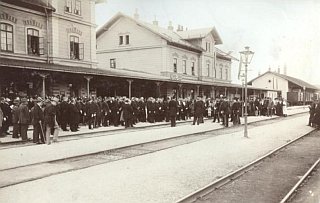
Bechyňská dráha, zahájení, nádraží, 1903
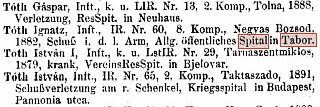
Wounded Hungarian soldiers in Tábor
, 9.1.1915

Táborské nádraží plays an important role in the plot because Švejk and Oberleutnant Lukáš's journey from Prague to Budějovice to join their regiment was unexpectedly interrupted here. This was after Švejk's many mishaps on the train, culminating in him pulling the emergency brake. As he couldn't pay the fine he had to leave the train to explain himself to the station master.
A benefactor at the station who were sympathetic to his plight paid the fine and gave him money for the trip onwards, but the money were spent at the station restaurant instead. Here Švejk treated a Hungarian reconvalescent with beer (one after the other) and the chance to buy a ticket onwards disappeared progressively with each beer.
Švejk was in the end discovered by a patrol and taken to the station's military commander who in the end ordered him to continue on foot. This was the beginning of his famous anabasis where he, despite his great enthusiasm, for a long timed struggled to join his regiment.
Tábor and the railway station is then mentioned several times when Wachtmeister Flanderka interrogates Švejk at Gendarmeriestation Putim. The soldier informs that station are easy to photograph because they don't move.
Background
Táborské nádraží (Tábor railway station) is the railway station in Tábor, situated appx. 2 km east of the town centre. It is one of the major stops on the line Prague - Budějovice.
The railway station was built between 1869 and 1971 and was used by the company Kaiser Franz Josephs-Bahn[1] who operated the line Prague - Vienna. Other important stops on the line were Benešov, Veselí nad Lužnicí, Třeboň and Gmünd. The station was also served Budějovice and from 1903 the local train to Bechyně. In 1914 the station also served lines going east-west: Jihlava - Domažlice. Station manager in 1914 was Vincenc Motyčka so this was the person Švejk would have reported to (if his mishaps were based on any real-life incident).
Magyars in Tábor
It may at first sight appear strange that Švejk would meet a wounded Hungarian soldier in Tábor, far from the Hungarian heartlands. Further investigations do however reveal that it was quite likely. Tábor had a large hospital, good railway connections, and admitted wounded soldiers from all over the monarchy. Lists of wounded and infirm from early 1915 show up several Hungarian names at this hospital.
Outbreak of war also led to the establishment of temporary hospitals. Already in August 1914 Sokol put their building at the disposal for sick-beds and the waiting rooms at the station were used by the Red Cross. In january 1915 military hospitals were also established elsewhere in town. That there were several of them in Tábor is also mentioned by the author.
Hašek at the station?
Jaroslav Hašek didn't write much about Tábor in his short stories so it is unclear if he ever visited before World War I. In February 1915 there is however no doubt that the train that brought him to Budějovice to enrol in Infanterieregiment Nr. 91 must have stopped here. The contingent of Landsturm recruits that Hašek belonged to was called up on 15 February 1915 and he enlisted at the regiment two days later. Whether this delay was due to a stop-over in Tábor or simply a result of queues during enrolment is anybody's guess. In the novel the author mentions two propaganda posters that fit fairly well with mid February 1915, namely those of Trainsoldat Bong and Zugsführer Danko. There is no doubt that he saw the items, otherwise he wouldn't have been able to describe them so accurately. It does however turn out the these propaganda motifs were all from the Kriegskalender for 1919 and some of them even describing events from 1917 so the possibility that Hašek observed them in February 1915 is none. It should also be added that his description of the station restaurant as "third class" doesn't seem to correspond to facts. Photos and other information indicates that it was an up-market establishment. See Táborská nádražní restaurace.
Quote(s) from the novel
[II.1] Zůstal průvodčí se Švejkem a mámil na něm dvacet korun pokuty, zdůrazňuje, že ho musí v opačném případě předvést v Táboře přednostovi stanice. „Dobrá,“ řekl Švejk, „já rád mluvím se vzdělanejma lidma a mě to bude moc těšit, když uvidím toho táborskýho přednostu stanice.“
[II.1] Celý personál četnické stanice podíval se na sebe pátravě a strážmistr pokračoval: „V Táboře jste byl tedy na nádraží. Máte něco u sebe? Vyndejte to.“
[II.1] Strážmistr opět vyměnil s celým personálem stanice významný pohled. „Ty vaše kruhy, to mně připadá, že se potloukáte po okolí. Zdržel jste se dlouho v Táboře na nádraží?“
[II.2] Asi před týdnem, po svém příjezdu k pluku, podal jste mně raport o přidělení sluhy, poněvadž se vám váš sluha ztratil na nádraží v Táboře. Poněvadž se vrátil...
Also written:Tábor railway stationenTábor BahnhofdeTábor jernbanstasjonno
| 1. | Nationalised and incorporated into k.k. Staatsbahnen 1 May 1884. |
Literature
- B(Tábor) průvodce po městě a jeho okolí, ,1886
- Průvodce okolím Tábora, ,1932
- Oba táborské odbory »Červeného kříže«, ,7.8.1914
- Nové lazarety v Táboře, ,5.1.1915
 | Táborská nádražní restaurace |  | ||||
| ||||||
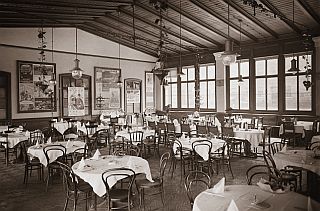
Interiér, Nádražní restaurace


, 4.6.1915
Táborská nádražní restaurace was a third class restaurant at the station in Tábor that was visisted by Švejk after he had to leave the train because of the episode with the emergency break. A friendly gentleman both paid his fine and also gave him a fiver for the journey onwards. Švejk however suffered the misfortune that he drank one beer after the other and he also invited a Hungarian reconvalescent to join him. The result was that he had no money left and had to continue on foot, thus starting on his famous anabasis.
Background
Táborská nádražní restaurace (Tábor station restaurant) is today (2010) a basic bistro but earlier it was a large and up-market restaurant with a summer terrace. It was situated between the two main blocks of the station building.
A restaurant existed at the station already from 1871 when the station opened, and in 1886 it was run by Antonín Jonáš. Who ran the restaurant through the years is unknown but in 1913 Antonín Stětina was in charge. He seems to have gone bankrupt in the spring of 1914.
From 1914 Jan Zimák is officially listed as proprietor and he was also in charge when Jaroslav Hašek passed through Tábor in mid February 1915. From August 1914 Zimák also provided food for the Red Cross clinic that was set up at the station. In 1915 the restaurant advertised itself as elegant, with excellent food, serving draught beer from Pilsen. In 1932 it was still operating and not much had changed - and the beer was still from Pilsen. The landlord was now Karel Hokův and he was listed as owner also in 1939. What happened to the restaurant since then is not known.
The information we have about the restaurant does not correspond to the author's description of it as "third class" so it must be assumed that he didn't visit himself, and that Švejk's stop-over is inspired by events that took place elsewhere.
Quote(s) from the novel
[II.1] Mezitím dobrý muž věřící v nevinnost Švejkovu zaplatil za něho v kanceláři pokutu a odvedl si Švejka do restaurace třetí třídy, kde ho pohostil pivem, a zjistiv, že všechny průkazy i vojenský lístek na dráhu nalézají se u nadporučíka Lukáše, velkomyslně dal mu pětku na lístek i na další útratu. When this large scale restaurant ceased to exist is not known.
Also written:Tábor station restaurantenTábor BahnhofgaststättedeTábor stasjonsrestaurantno
Literature
- Kam budeme chodit na práve víno a dobré pivo, ,16.12.1871
- B(Tábor) průvodce po městě a jeho okolí, ,1886
- Živnostní koncessované, ,1.9.1914
- Průvodce okolím Tábora, ,1932
 | Traineskadron Nr. 3 |  | ||||
| Kraków, ul. Zwierzynieckiej | ||||||
| ||||||

Verordnungsblatt für das k.u.k. Heer, 5.12.1914

Grazer Tagblatt, 19.2.1915
,19.2.1915
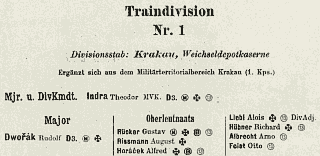
Schematismus für das K.u.k. Heer.., 1914
1914
Traineskadron Nr. 3 is mentioned as the unit where the Trainsoldat Bong performed his heroic deeds. This according to a propaganda poster Švejk observed at Táborské nádraží.
Background
Traineskadron Nr. 3 refers to the 3. squadron of Traindivision Nr. 1, a supply unit in k.u.k. Heer. Trainsoldat Bong was real enough, confirmed by several newspaper notices in early 1915.
Supply divisions
K.u.k. Heer had 16 Traindivisionen (supply divisions), numbered according to the army district from which they were recruited. Armeekorps Nr. 1 and the Kraków military distric covered western Galicia and parts of Silesia and Moravia and this is where Traindivision Nr. 1 were recruited from. Czech cities like Moravská Ostrava, Opava and Olomouc were thus within the district, together with notable Polish cities like Kraków, Cieszyn, Wadovice, Nowy Targ, and Tarnów.
The 16 train (supply) divisions consisted of a varying number of squadrons. Traindivision Nr. 1 was garrisoned in Kraków itself, in the so-called Weichseldepotkaserne (in 1918 renamed koszary Bartosza Głowackiego). It was located near the centre in ul. Zwierzynieckiej.
Head of Traindivision Nr. 1 since 1 November 1912 was Major Theodor Indra, from 1 May 1915 Oberstleutnant. A glance at the list of officers from 1914 reveals a curiosity: none of them had Polish surnames, all the officers seem to have been Czechs or Germans.
Quote(s) from the novel
[II.1] Zatímco šikovatel šel shánět nějakého důstojníka, Švejk si přečetl na plakátu:
VOZATAJEC JOSEF BONG
Vojáci zdravotního sboru dopravovali těžce raněné k vozům, připraveným v kryté úžlabině. Jakmile byl plný, odjelo se s ním na obvaziště. Rusové, vypátravše tyto vozy, počali je obstřelovati granáty. Kůň vozatajce Josefa Bonga od c. a k. 3. vozatajské švadrony byl usmrcen střepinou granátu. Bong bědoval: „Ubohý můj bělouši, je veta po tobě!“ Vtom sám zasažen byl kusem granátu.
Literature
- Schematismus für das k.u.k. Heer (s. 990), ,1914
- Traindivisionen, ,2001 - 2016
- Trainwesen der Österreichisch-Ungarischen Streitkräfte,
- Landespferdesucht, ,4..1909
- Rozkaz Nr. 11,
 | K.k. Schützenregiment Nr. 21 |  | ||||
| St. Pölten, Schießstattring 8 | ||||||
| ||||||
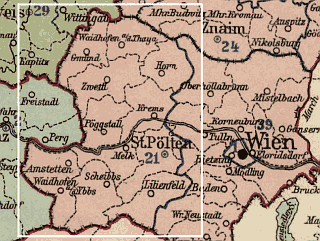
Landwehr-Ergänzungsbezirk Nr. 21, 1913
1913
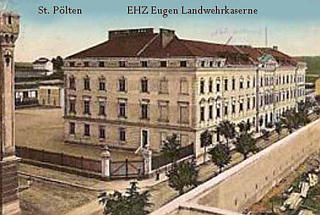

Eggenburger Zeitung, 6.4.1917

,Jänner 1918
K.k. Schützenregiment Nr. 21 is mentioned in passing as Švejk at the station in Tábor observes a propaganda poster that features Zugsführer Hammel, Korporal Paulhart, and Korporal Bachmayer. All three served in this regiment.
Background
K.k. Schützenregiment Nr. 21 was one of 37 Austrian k.k. Landwehr infantry regiments. Together with most of its peer units it was established in 1889. The recruitment district was St. Pölten and consisted of roughly the western half of current Niederösterreich. Some of the men were also recruited from the district Vienna B. Ethnically the regiment was almost entirely German. Staff and all three battalions were in 1914 garrisoned in St. Pölten. Commander in 1914 was Oberst Eduard von Dietrich[a].
The regiment was housed in a barrack complex at Schießstattring (Eugenkaserne, Rainerkaserne and Franz-Josephs-Kaserne), now Hesserkaserne[b].
During the war they first fought on the eastern front. In 1915 they were relocated to the Italian front and transported to Galicia in 1916 after the Brusilov offensive. Thereafter they were sent back to the south-west front where they took part in the advance on Piave in the autumn of 1917.
K.k. Landwehr ⇒ K.k. Schützen
It was only in 1917 that the term Schützenregiment (Rifle Regiment)[1] was officially introduced as all k.k. Landwehr units were renamed in April that year. This indicates that the author drew inspiration from propaganda material originating from late in the war, and not from what he himself may have witnessed in 1915. See the next paragraph for confirmation of this hypothesis.
1. The translation into English by Cecil Parrott erroneously concludes that this was an artillery regiment.
Tagliamento, 1917
The events that were described on the posters that Švejk observed in Tábor in early 1915 actually took place, but almost three years later. Zugsführer Hammel, Korporal Paulhart and Korporal Bachmayer all served in k.k. Schützenregiment Nr. 21 and they were mentioned together in a battlefield report in early 1918. The title was Das St. Pöltner Schützenregiment Nr. 21 am Tagliamento and it was printed in Streffleur's Militärblatt, Linzer Volkszeitung a.o. It dealt with the regiment's engagement by the river Tagliamento in northern Italy on 5 November 1917, and includes a few lines about the three soldiers who are mentioned in The Good Soldier Švejk. All three distinguished themselves during the battle and were awarded silver medals for bravery.
Korporal Paulhart and Korporal Bachmayer have been identified and information about them confirmed by their Belohnungsantrag whereas the identity of Zugsführer Hammel remains unclear (probably due to a misspelling of his surname).
Not invented
In The Good Soldier Švejk it is claimed that these posters were created at k.u.k. Kriegsministerium by conscripted German journalists. This was often true and Egon Erwin Kisch is only one example. On the other hand: the claim that the soldiers on the posters were "invented rare model soldiers" is not true. Zugsführer Hammel, Korporal Bachmayer, Korporal Paulhart, Zugsführer Danko, and Trainsoldat Bong were all real people but their exploits were obviously glorified for propaganda purposes. See Kriegskalender for more on this theme.
Quote(s) from the novel
[II.1] Dobrého vojáka Švejka uvítal obraz znázorňující dle nápisu, jak četař František Hammel a desátníci Paulhart a Bachmayer od c. k. 21. střeleckého pluku povzbuzují mužstvo k vytrvání. Na druhé straně visel obraz s nadpisem: „Četař Jan Danko od 5. pluku honvédských husarů vypátrá stanoviště nepřátelské baterie.“
Literature
- Das St. Pöltner Schützenregiment Nr. 21 am Tagliamento, ,12.1.1918
- Das St. Pöltner Schützenregiment Nr. 21 am Tagliamento, ,24.2.1918
- Schematismus der k.k. Landwehr (s. 265), ,1914 [a]
- Hesserkaserne, [b]
- Geschichte von den Einundzwanzigern, ,1917
- Der Oberste Kriegsherr und sein Stab, ,1908
| a | Schematismus der k.k. Landwehr (s. 265) | 1914 | |
| b | Hesserkaserne |
 | K.u. Honvéd Husaren Regiment Nr. 5 |  | ||||
| Kassa (Košice) | ||||||
| ||||||
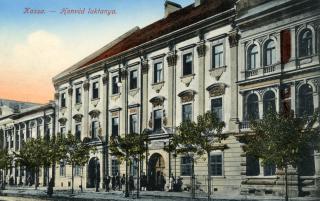
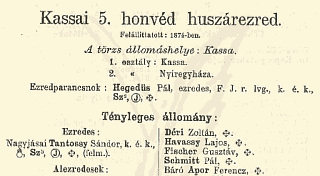
Honvédség és Csendőrség Névkönyve, 1914

Oesterreichische Volks-Zeitung, 21.10.1914
K.u. Honvéd Husaren Regiment Nr. 5 is mentioned in passing as Švejk at the station in Tábor observes a propaganda poster that features Zugsführer Danko from this regiment.
Background
K.u. Honvéd Husaren Regiment Nr. 5 (M. kir. 5. Honvéd Huszárezred) was one of 10 Hungarian Honvéd cavalry regiments. It was recruited from Honvéd district no. III Kassa (now Košice). Commander in 1914 was Oberst Pál Hegedűs. The regiment was garrisoned in Košice and Nyíregyháza.
During the war
Immediately upon outbreak of war the regiment was sent to the front in Galicia and had their baptism of fire on 15 August 1914 by Stojanów (now Стоянів) on the border with Russia. They experienced the disastrous defeat at the end of August that forced Austria-Hungary to abandon Lemberg. At the turn of the year they were fighting in the Carpathians and took part in the advance eastwards from early May 1915. By now they were however operating as foot soldiers. In the summer of 1916 they were moved to the front against Romania whereas the final year of the war was spent fighting on the Italian front.
Dankó János
In 1935 the regiment's history was published as a book. The history confirms that Zugsführer Danko, the soldier Švejk observed on a propaganda poster in Tábor, indeed was a Zugsführer in the regiment and took part in the early battles in Galicia. His Hungarian name was János Dankó but he may also have been a Slovak.
Quote(s) from the novel
[II.1] Dobrého vojáka Švejka uvítal obraz znázorňující dle nápisu, jak četař František Hammel a desátníci Paulhart a Bachmayer od c. k. 21. střeleckého pluku povzbuzují mužstvo k vytrvání. Na druhé straně visel obraz s nadpisem: „Četař Jan Danko od 5. pluku honvédských husarů vypátrá stanoviště nepřátelské baterie.“
Literature
 | Honvéd |  | ||||
| Budapest I., Szent György tér 3 | ||||||
| ||||||
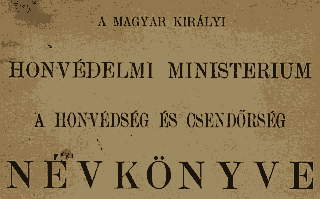
A Magyar Királyi Honvédelmi Ministerium, a Honvédség és Csendőrség Névkönyve 1895

Feldküche eines Honved-Infanterieregimentes
,20.8.1914
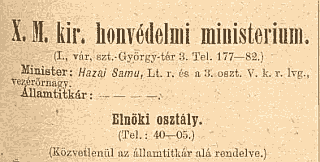
, 1910
Honvéd is mentioned many times in The Good Soldier Švejk, mostly from Királyhida and onwards. In [II.3] soldiers from Honvéd directly under the plot during the brawl in Királyhida. Before that they had been mentioned in connection with k.u. Honvéd Husaren Regiment Nr. 5 and also Hauptmann Spíro's listing the various branches of k.u.k. Wehrmacht.
Background
Honvéd (Magyar Királyi Honvédség) was the Hungarian land guard, an equivalent to the Austrian k.k. Landwehr. It consisted of 32 infantry regiments, 10 cavalry regiments, 8 field artillery regiment and various auxiliary functions. The Hungarian land guard was recruited from 6 districts (Budapest, Szeged, Kassa (Košice), Pozsony (Bratislava), Kolozsvár (Cluj), Zágráb (Zagreb)). Each infantry regiment consisted of three battalions and the service lasted for two years. The recruits were distributed between Honvéd and the Gemeinsame Armee by drawing lots, just like in Cisleithania.
Despite the names that suggest territorial armies both Honvéd and k.k. Landwehr were fully operative troops that during wartime were given much the same tasks as the common army. As opposed to k.u.k. Heer and the Austrian Landwehr the command language was Hungarian and also Croat[1].
Backround
The term Honvéd first appeared during the revolution and Hungarian uprising against Habsburg rule in 1848. The following year the rebellion was put down (with Russian help) and Honvéd was dissolved. After the 1867 Ausgleich they were reconstituted as a home defence force in Transleithanien and as such formed part of the military command structure of the Dual Monarchy.
The Honvéd ministery
Politically Honvéd reported to the Hungarian Royal Honvéd Ministry (Magyar Királyi Honvédelmi Minisztérium) that were located in Buda. Minister from 1910 til 1917 was general Samu Hazai (1851-1942), the highest ranking Jewish officer in the entire k.u.k. Wehrmacht. In 1917 he was succeeded by Sandor Szurmay (1860-1945) who thus became the last ever Honvéd minister. Honvéd was dissolved after World War I and today the term describes the entire Hungarian army.
Quote(s) from the novel
[II.1] Na druhé straně visel obraz s nadpisem: "Četař Jan Danko od 5. pluku honvédských husarů vypátrá stanoviště nepřátelské baterie."
[II.2] ... tyrolské císařské střelce, bosenské pěšáky, uherské pěší honvédy, uherské husary, ...
[II.3] Český voják vyspí se s maďarskou dívkou a ubohá česká děvečka přijme k sobě maďarského honvéda, a po staletích bude to zajímavé překvapení pro antropology, proč se objevily vysedlé lícní kosti u lidí na březích Malše.“
[II.3] Zato jsme jim to tam, tajtrlíkům maďarským, vodplatili pořádně u Neziderskýho jezera, na který jsme se šli před třemi tejdny podívat. Leží tam ve vedlejší vsi nějaký oddělení strojních pušek nějakejch honvédů, a my jsme náhodou všichni zašli do jedný hospody, kde voni tančili ten svůj čardáš jako pominutý a roztahovali si držku na celý kolo se svým ,Uram, uram, biró uram’ nebo ,Láňok, láňok, láňok a faluba’.
[II.3] Tak ten náš Mejstřík skočí do kola a tu největší fešandu chce brát jednomu honvédovi, kerej začal něco brebentit, a Mejstřík mu hned jednu hodil, ten se svalil, my už hned chytli überšvunky, votočili jsme si je kolem ruky, aby nám bajonety neulítly, skočili mezi ně, já jsem vykřik: ,Vinnej nevinnej, berte to po řadě!’ a už to šlo jako na másle.
[II.3] Pana Kákonyiho odtáhli do protějšího průjezdu, kde ho polívali vodou, a uprostřed ulice bil se starý sapér Vodička jako lev proti několika honvédům a honvéd-husarům, kteří se zastali svého krajana.
[II.4] "Netvař se tak vážně, Švejku, ono ti to na frontě přejde, prát se s nějakými honvédy," pokračoval, "líčení se s vámi oběma zastavuje a každý z vás jde k své části, kde budete potrestáni u raportu, a pak půjdete s marškou na frontu.
| 1. | In Honvéd units that were recruited from the autonomous kingdom of Croatia and Slavonia, the command language was Croat. |
Literature
- Das neue Wehrsystem und Ungarn, ,23.1.1867
- Honvédelmi Ministerium Névkönyve, ,1895
 | Feldjägerbataillon Nr. 7 |  | ||||
| Canale (Kanal ob Soči) | ||||||
| ||||||
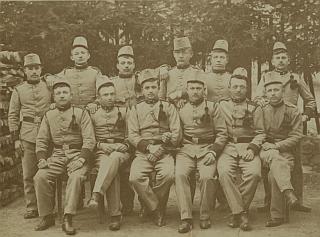
7. Feldjägerbataillon. Champagne in Tolmin
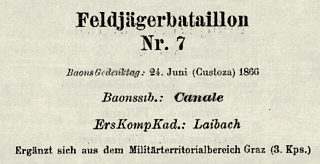
Schematismus für das k.u.k. Heer..., 1914
1914

Kaserne in Tolmein
Feldjägerbataillon Nr. 7 is mentioned by Švejk in a conversation with a k.k. Landwehr soldier at the railway station in Tábor. Švejk has read in Pražské úřední listy about the heroic deeds of Doctor Vojna, a one-year volunteer from this battalion.
Background
Feldjägerbataillon Nr. 7 was one of 32 Feldjäger (light infantry) battalions in k.u.k. Heer. The regiment was formed as early as 1808 and took part in the campaigns against Italy around the middle of the century. The replacement battalion was located in Laibach (now Ljubljana). Staff and the troops were from 1905 to 1914 garrisoned in Canale and Tolmein[1] by the river Isonzo on the border with Italy, currently in Slovenia. The vast majority of the battalion's soldiers were Slovenes. Battalion commander in 1914 was Oberstleutnant Wilhelm Staufer. The battalion formed part of 94. Infanteriebrigade in Tolmein who in turn reported to 28. Infanteriedivision in Laibach.
Detailed information about the battalion during World War I is scarce. Österreich-Ungarns letzter Krieg reveals that they were now assigned to 56. Infanteriebrigade, still reporting to 28. Infanteriedivision, III. Korps, operating on the eastern front. In 1914 they were involved in battles by Gologóry, Jaroslav, Przemyśl, Homonna and Dukla. For the rest of the war it is difficult to trace them but in July 1916 they were fighting south of Valsugana on the Tirolean front. Their exploits here were even mentioned in the daily official war bulletins.
1. Slovenian: Kanal ob Soči, Tolmin
Quote(s) from the novel
[II.1] Když Švejk dočetl a šikovatel se ještě nevracel, řekl k landverákům na strážnici: „Tohle je moc krásnej příklad zmužilosti. Takhle budou u nás v armádě samý nový postroje na koně, ale když jsem byl v Praze, tak jsem čet v Pražskejch úředních listech ještě hezčí případ vo nějakým jednoročním dobrovolníkovi Dr Josefu Vojnovi. Ten byl v Haliči u 7. praporu polních myslivců, a když to přišlo na bodáky, tak dostal kulku do hlavy, a když ho vodnášeli na obvaziště, tak na ně zařval, že kvůli takovému šrámu se nenechá obvázat.
Literature
- Schematismus für das k.u.k. Heer (s. 598), ,1914
- Die k.u.k. Feldjäger,
- Truppenverschiebungen, ,19.2.1905
- Nachrichten aus den Hauptquartieren, ,24.7.1916
- Der Oberste Kriegsherr und sein Stab, ,1908
 | Pražské úřední listy |  | ||||
| Praha III./387, Karmelitská ul. 6 | ||||||
| ||||||
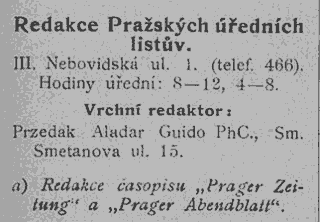
Adresář královského hlavního města Prahy a obcí sousedních, 1907
Pražské úřední listy is referred to by Švejk at the station in Tábor. In this paper he had read about the glorious deeds of the one-year volunteer Doctor Vojna from Feldjägerbataillon Nr. 7.
Background
Pražské úřední listy (Prague Official Newspaper) was a collective term that applied to the newspapers of c.k. Místodržitelství (k.k. Statthalterei) in Prague. These newspapers were mouthpieces of the Austrian authorities in Bohemia, headed by the Statthalter (governor). For more information see Pražské úřední noviny.
Quote(s) from the novel
[II.1] Když Švejk dočetl a šikovatel se ještě nevracel, řekl k landverákům na strážnici: „Tohle je moc krásnej příklad zmužilosti. Takhle budou u nás v armádě samý nový postroje na koně, ale když jsem byl v Praze, tak jsem čet v Pražskejch úředních listech ještě hezčí případ vo nějakým jednoročním dobrovolníkovi Dr Josefu Vojnovi. Ten byl v Haliči u 7. praporu polních myslivců, a když to přišlo na bodáky, tak dostal kulku do hlavy, a když ho vodnášeli na obvaziště, tak na ně zařval, že kvůli takovému šrámu se nenechá obvázat.
Also written:Prague Official NewspaperenPrager AmtsblattdePraha Amtsbladno
Literature



|
II. At the front |
 | |
1. Švejk's mishaps on the train | |||
| © 2008 - 2024 Jomar Hønsi | Last updated: 20.11.2024 |


